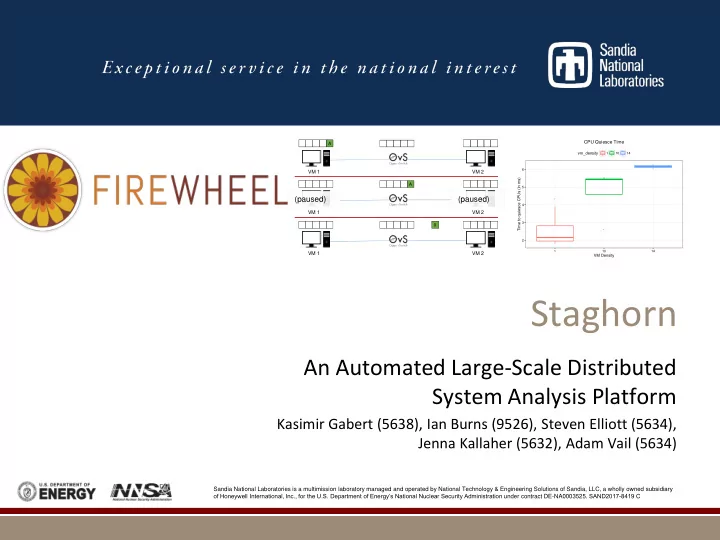

CPU Quiesce Time A vm_density 1 10 14 6 VM 1 VM 2 Time to quiesce CPUs (in ms) A 5 (paused) (paused) ● 4 VM 1 VM 2 3 X ● 2 1 10 14 VM 1 VM 2 VM Density Staghorn An Automated Large-Scale Distributed System Analysis Platform Kasimir Gabert (5638), Ian Burns (9526), Steven Elliott (5634), Jenna Kallaher (5632), Adam Vail (5634) Sandia National Laboratories is a multimission laboratory managed and operated by National Technology & Engineering Solutions of Sandia, LLC, a wholly owned subsidiary of Honeywell International, Inc., for the U.S. Department of Energy’s National Nuclear Security Administration und er contract DE-NA0003525. SAND2017-8419 C
Problem Large, distributed systems have become ubiquitous A common method for understanding their behavior is to simply run them and observe / experiment (Emulytics) This necessarily competes with the model for CPU time, and the model and analysis must run at clock rate We built a way to “stop time” within a model, opening the door to the larger world of offline model analysis 2
A Few Use Cases Vulnerability analysis Debugging systems Optimizing tests Experimental repeatability Training 3
Key Contributions A full- system snapshot and restore capability for Sandia’s large-scale emulation-based model environments which preserves network and I/O state A network modification system that allows for modification of Ethernet frame contents and delivery, or the introduction and removal of frames, during a snapshot The evaluation of this capability on real-world use-cases 4
Design Requirements The system must not perceive that a snapshot has occurred Staghorn must preserve machine and network state Staghorn must snapshot quickly so that each virtual machine is snapshotted within a tight time window 5
Firewheel Staghorn is built on top of Firewheel, Sandia-developed tool for automating the challenging parts in Emulytics Two big technologies Firewheel brings: Graphs to represent models Plugin architecture to make automation extensible Firewheel is scalable: to 75,000 VMs booting in 13 minutes 6
Staging Architecture 7
VM State Snapshots Currently using QEMU migration-based snapshots Straightforward to implement because they utilize existing QEMU mechanisms. Explored two other approaches: Process-level snapshots QEMU fork-based snapshots 11
Network Snapshots Design decisions: Should we prioritize packet latency or packet ordering? Choose packet ordering but minimize queuing delay as much as possible How to pass information to/from the kernel? Netlink, it is quick, asynchronous, and easy to implement Where should we place our modifications? Open vSwitch 12
Why OVS Can capture packets between cohosted VMs Easy to install and actively developed Compatible with virtualization platforms (KVM, Xen, etc.) Already works with both Minimega and Firewheel 18
Network Snapshot Architecture netif_rx ksoftirqd do_softirq net_rx_action netif_receive_skb Linux NIC Open vSwitch Datapath rx_handler netdev_port_receive ovs_vport_recieve Staghorn ovs_dp_process_received_packet execute_actions do_output ovs_vport_send vport->ops->send(vport, skb) 19
Evaluation – precisetimer.so Tried to sleep 1 second into the future 60 times and measured how close the sleep was to the desired time. Results ranged from 1 – 55 ns with mean of 28.05 ns precisetimer.so Error Measurement Sleep error (in nanoseconds) 40 20 0 0 20 40 60 Iteration 20
Evaluation - RabbitMQ RabbitMQ Delay Measurement remote − host same − host type Delay error (in ms) 1.5 1.0 0 10 20 30 Time (seconds) 21 fi fi fl fl ignific
Evaluation – Snapshot Timing One of the most critical timing aspects of Staghorn is the performance of quiescing the virtual CPUs on each VM vm_density 1 10 14 6 Time to quiesce CPUs (in ms) 5 ● 4 3 ● 2 1 10 14 VM Density 22 ’
Use Cases – Distributed Fuzzer Greedily choose message modification with largest metric to take Fork execution by taking snapshot and returning to it Evaluate metric after different message modifications After many greedy message choices an issue is found 23
Use Cases – Distributed Fuzzer A VM 1 VM 2 24
Use Cases – Distributed Fuzzer A (Paused) (Paused) VM 1 VM 2 25
Use Cases – Distributed Fuzzer X VM 1 VM 2 26
Use Cases – Distributed Fuzzer A (Paused) (Paused) VM 1 VM 2 27
Use Cases – Distributed Fuzzer Y VM 1 VM 2 28
Use Cases – Distributed Debugger 1. Set breakpoint 2. Install Staghorn Trigger 3. Staghorn will wait until the breakpoint is hit to snapshot the system. 29
Use Cases – Debug Experiments Firewheel user’s experiment failed after about 8 hours. An 8 hour debug cycle is unacceptable. Staghorn was used to snapshot before the crash enabling the user to quickly test various fixes. 30
Conclusion/Future Work Conclusion We have opened the door to offline analysis and modification for our large-scale emulation based models Follow-on work: Improve our performance Implement/productize more use cases Better identify how long it takes for CPUs to quiese and improve this time Improve the stability of process-level snapshots and QEMU fork-based snapshots 31
Any Questions?? Paper: www.sandia.gov/emulytics/staghorn-report.pdf Contact info: Steven Elliott (selliot@sandia.gov) 32
Recommend
More recommend